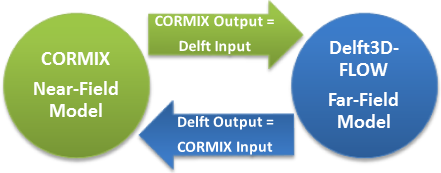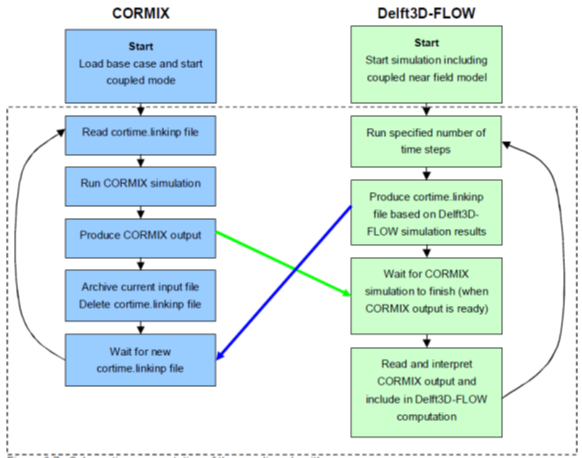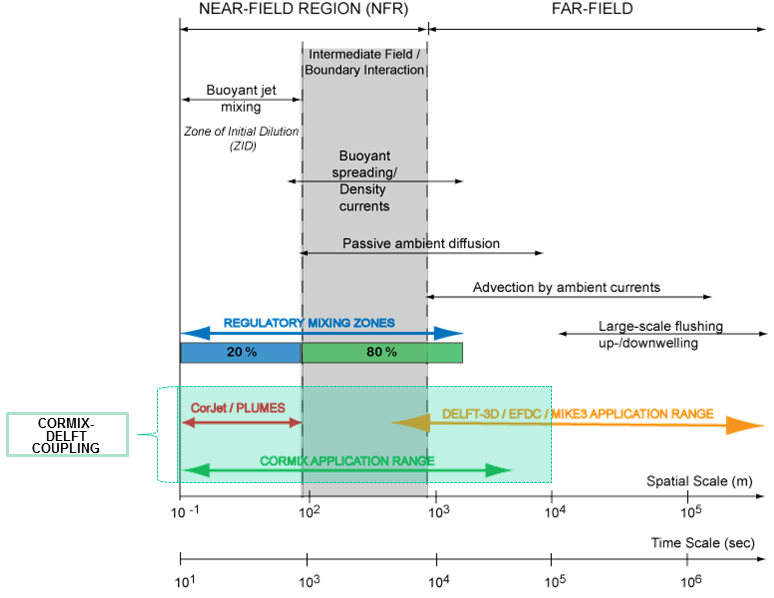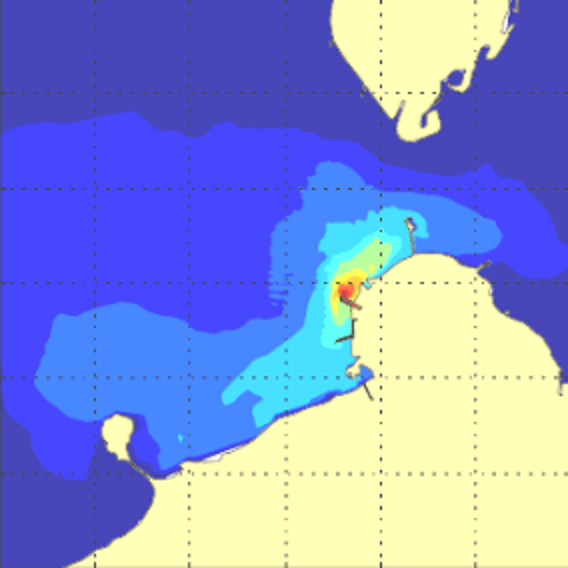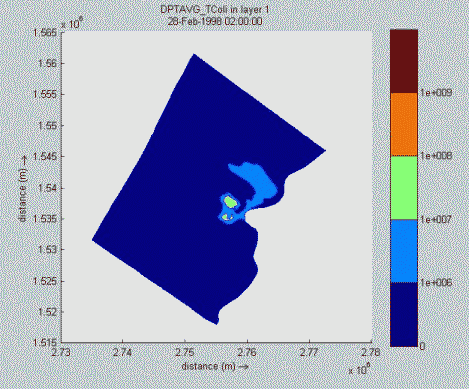MixZon Inc and Deltares recently entered into a cooperative agreement to collaborate and provide services in
Environmental Consultancy and Mixing Zone Modeling and Analysis using the CORMIX-DELFT3D Coupled Modeling Technique, developed jointly by MixZon (developers of the CORMIX model) and Deltares (developers of the Delft3D-FLOW model).
As part of this cooperative agreement, the CorTime tool in CORMIX was updated and developed to facilitate the automated, two-way, dynamic linkage and coupling of the CORMIX near-field model to the Delft3D-FLOW far-field model.
The coupled modeling option is invoked by choosing the "Coupled Mode (Delft3D-FLOW)" option in the CorTime UI in the CORMIX GTR version.
Introduction:
There is an increasing amount of coastal activities and industries that discharge waste water world-wide; Some examples include
power plants, desalination plants, municipal waste water outfalls, etc.
All these outfalls have some impact on the environment and generally need to comply with local environmental criteria and regulations.
Additionally, for efficient and economic operation, existing and new designs need to be optimized to improve mixing performance
(E.g. to account for recirculation, time varying ambient and discharge conditions, interaction with other nearby outfalls, etc.).
Therefore, it is necessary to be able to assess the outfall plume behavior accurately. This is usually achieved by means of numerical modeling and/or resource intensive field validation studies.
Coupled Modeling - Motivation:
Effluent plume behavior from outfall(s) varies over different space and time scales.
Near-field plume behavior is generally dominated by turbulent, buoyant jet mixing and usually occur in short space and time scales (less than 1 to 100s of meters; several seconds to a few hours).
Far-field plume effects and impacts are dominated by prevalent ambient conditions and usually occur in large space and time scales (several 100s of meters to multiple kilometers and several hours to days).
Generally the plume behavior in the near-field is controlled by the source properties (close to outfall)and can be influenced by outfall design and configuration.
Plume behavior in the far-field are dependent on ambient properties such as large scale ambient flow, tidal variations, recirculation, etc.
The CORMIX Mixing Zone Model (steady-state model) can provide good estimates of effluent plume behavior in the near-field.
The Delft3d-FLOW model is a far-field hydrodynamic model that simulates non-steady flows and incorporates the effects of tides, winds, air pressure, density differences, waves, turbulence and drying and flooding
and can be applied to compute the far-field behavior of the plume and recirculation effects.
Currently, there is no single model that covers all the scales of plume behavior described above in a feasible manner. Hence, to accurately and efficiently cover and assess all scales of the plume behavior, we need to couple near-field and far-field models.
Coupling Methodology:
Model coupling is often done offline (one-way) by running a separate near-field model (CORMIX) that defines a source term for the far-field model (Delft3d-FLOW).
However, in order to take into account the time varying ambient conditions in the near-field model and even part of the entrainment processes in the far-field model, this online and dynamic (two-way) coupling is necessary.
The coupling between CORMIX and Delft3D-FLOW models further includes the Distributed Entrainment Sinks Approach (DESA) by Choi and Lee2.
Coupled Modeling Results:
Based on a recently concluded modeling analysis and field validation study, some observed physical phenomena in field data and reproduced by the CORMIX-Delft3D-FLOW coupled modeling approach (and not in traditional modeling methods) are described below:
1. Varying location where the effluent plume surfaces due to tidal currents.
2. More accurate estimate of the surface excess temperature in non-stratified ambient conditions (+1.5°C at surface, matching the field measurements, instead of +8°C predicted by traditional modeling approaches.
3. Proper inclusion of entrainment processes in the far-field model, resulting in the reproduction of phenomena observed in the field data that could not be modelled in traditional approaches, such as locally altered stratification due to the outfall plume and corresponding plume behavior.
These improvements in the modelling accuracy have shown to make a substantial difference in the environmental permitting procedure and (intake and) outfall design.
In conclusion, a dynamic, two-way model coupling of CORMIX and Delft3D-FLOW allows us to obtain a more accurate and comprehensive method for modeling the complete trajectory of a waste water outfall(s) plume(s) and their interactions,
allowing an accurate assessment of the environmental effects and the design of possible mitigating measures.


CORMIX-Delft3D Model Linkage1 |
||||||
|
|
Collaborative Agreement: CORMIX-DELFT3D Coupled Modeling Technique.
Dynamic, two-way model coupling.
Dynamic, two-way model coupling flow chart.
Dynamic, two-way model coupling Space & Time Scales.
Dynamic, two-way model coupling allows us to obtain a more accurate and comprehensive method for modeling the complete trajectory of a waste water outfall(s) plume(s) and their interactions, allowing an accurate assessment of the environmental effects and the design of possible mitigating measures.
Application of CORMIX - Delft3D-FLOW Coupling. Time series analysis and visualization of depth averaged concentration [MPN/m3] of total coliforms from offshore multiport discharge.
Reference: "Coupling hydrodynamic models for multiport diffusers: design and siting of the Cartagena outfall", Dr. Tobias Bleninger, IFH - University of Karlsruhe.
|
|||||
|
Please review the CORMIX Feature Comparison table for CORMIX v12.0 versions,
to check for CorTime availability or contact us for more information.
|
||||||


